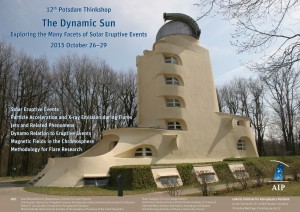Critical Decay Index at the Onset of Solar Eruptions
Francesco Zuccarello (LESIA, Observatoire de Paris)
Abstract. Magnetic flux ropes are topological structures consisting of twisted magnetic field lines that globally, but not uniformly, wrap around an axis. The torus instability model predicts that a magnetic flux rope embedded in an ambient field undergoes an eruption when its axis reaches a location where the decay index of the overlying magnetic field is larger then a critical value that, in current-wire models, depends on the thickness and time-evolution of the current channel. By using magneto-hydrodynamic (MHD) simulations we aim to investigate whether or not the critical value of decay index at the onset of MFR’s eruptions is affected by the magnetic flux rope’s internal current profile and/or by the particular pre-eruptive photospheric dynamics. The evolution of an asymmetric, bipolar active region is driven by applying, at the lower boundary, different classes of photospheric motions ranging from convergence of the magnetic flux closet to the active region’s polarity inversion line (PIL) to asymmetric stretching, peripheral and global dispersal of the active region. Despite different flows resulting in significantly different magnetic flux distributions at the photopshere, we find that the critical value of the decay index at the onset of the eruption is not significantly affected by the pre-erupitve photospheric evolution of the active region and by the resulting different magnetic flux ropes. As for the case of the current-wire models, we find that there is a `critical range’ rather than a `critical value’ for the onset of the torus instability. This range of critical values is in good agreement with the predictions obtained using a current-wire formulation of the problem, despite the inclusion of line-tying effects and the occurrence of tether-cutting magnetic recconnection.
Contributed Talk

Write a comment Close comment form